Audio Creative Best Practices: Say The Brand Name Early And Often, Don’t Get Caught Up On Spot Length, And Utilize The Power Of AM/FM Radio And Podcast Personalities
Click here to view a 10-minute video of the key findings.
Focusing on creative is critical for advertisers and brands. According to Analytic Partners, “Creative is a key driver of advertising performance/campaign effectiveness, second only to investment levels.” In fact, a Nielsen Catalina study of nearly 500 campaigns found that creative contributes to nearly half of all sales lift.
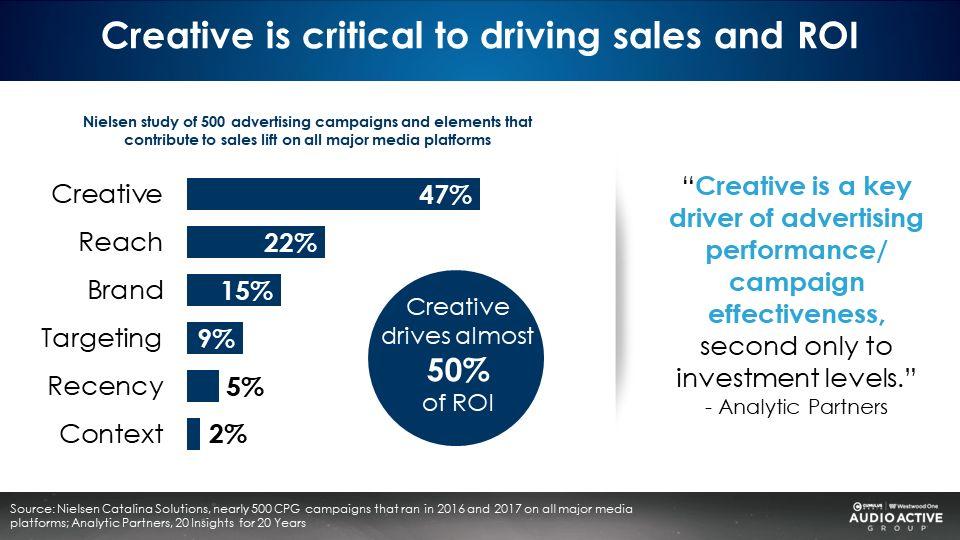
Cumulus Media | Westwood One Audio Active Group®’s comprehensive Audio Creative Best Practices
The Cumulus Media | Westwood One Audio Active Group® has tested hundreds of audio ads over the years working with the leading experts in creative testing: ABX, Veritonic, and Sensory Logic. The findings from those tests, along with marketing effectiveness and creative strategy work from industry giants like Les Binet, Peter Field, Alice Sylvester, Byron Sharp, Leslie Wood, Paul Feldwick, Jenni Romaniuk, and Orlando Wood, have been combined to form Cumulus Media | Westwood One Audio Active Group®’s comprehensive Audio Creative Best Practices.
By fine tuning audio creative, advertisers and brands can achieve marketing’s two equally important jobs.
The jobs of marketing: Converting existing demand and creating future demand
Rethinking Brand for the Rise of Digital Commerce, a major new marketing effectiveness study from James Hurman, Founding Partner of Previously Unavailable, and WARC, the World Advertising Research Center, reveals marketers need to convert existing demand and create future demand. James Hurman just published a wonderful new book on how to create future demand entitled Future Demand: Why Building Your Brand Among Tomorrow’s Customers Is The Key To Start-Up Success.
Hurman explains the difference between the two as:
“Convert existing demand – making sure we’re advertising to that relatively small group of consumers who are ready to buy, and capturing as large a share as possible of them for our product.
Creating future demand – advertising to that much larger group of consumers who are not ready to buy now, but will be in [the] future, and making them feel familiar with and positively toward us, so that they gravitate to us when they enter the category.”
According to Hurman, the way to convert existing demand is by tightly targeting with rational messaging (ie. product information or price) that can persuade consumers to choose one product over another.
The best way to create future demand is through targeting broad audiences with emotional messaging. This type of creative is meant to stand out and “create positive memories of [a] brand that will influence future purchase decisions.”
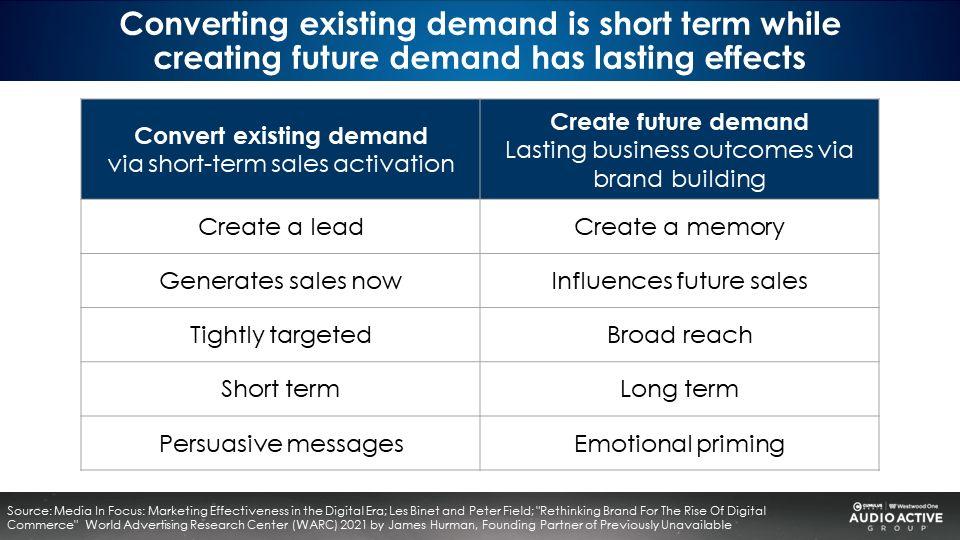
In both cases, audio creative is the lever that advertisers and brands can pull in order to achieve either the goal of short-term sales activation or lasting brand building.
Here are some key creative best practices that can be employed for both outcomes:
The first five seconds matter: Say the brand early and often
According to Nielsen, “Consumer engagement drops off after the first 5 seconds.” They advise that saying the brand name early and often in audio creative “ensures a consumer connection early on and reinforces the remembrance at the end of the ad.”
Don’t waste time at the start of the ad getting into premise or too much of the story. By putting the name of the brand first, listeners will have no question of what ad they are listening to. Nielsen data also finds that saying the brand name more often drives higher recall.

According to hundreds of Nielsen brand effect studies, mentioning the brand name 1-2 times in an ad generates 59% brand recall. Increasing the brand name mentions to 7+ times boosts brand recall up to 77%.
Nielsen finds increased brand mentions drive greater brand equity. As brand mentions grow, brand familiarity, affinity, and likelihood to seek information increase.
Ensuring your brand is prominent in advertising creative is of great importance, says Jenni Romaniuk from the prestigious Ehrenberg-Bass Institute for Marketing Science. Failure to brand is one of the three reasons why advertising fails, says Romaniuk: “The brand name anchors the exposure in the right part of memory, without the brand, any noticed ad is a creative endeavour with little useful ROI. Much of the paid for reach is wasted because it failed to brand. Whether via the brand name or distinctive assets, we need to get better at branding in every media environment so advertising can work for the brand.”
Questions to ask:
- Does my brand name appear within the first three seconds of the ad?
- Were there 5+ mentions of the brand in the 30-second ad?
- Does the brand have a memorable jingle with a melody that says the name of the company so people can remember the advertiser?

Don’t get caught up on spot length: While longer ads do perform marginally better, in the grand scheme of audio creative, the length of an ad is a minor factor in effectiveness
Longer ads see modest improvements in effectiveness but aren’t always as efficient. Instead, pay attention to other creative aspects of the ad for more impact.
Focus instead on the number of messages included and using consistent, unified creative across media.
The fewer messages, the better the advertising recall

Creative testing giant Millward Brown reports the more messages an ad attempts to communicate, the lower the likelihood of a single message being communicated. Their data shows that the first message in an ad with four messages has only 43% of the recall of an ad with one message.
Use consistent creative with a unified message across different media
Some marketer campaigns feature different creative approaches and messaging in different media. Millward Brown finds brands using unified creative campaigns with the same message and approach across different media achieve 57% greater effectiveness than non-unified campaigns.
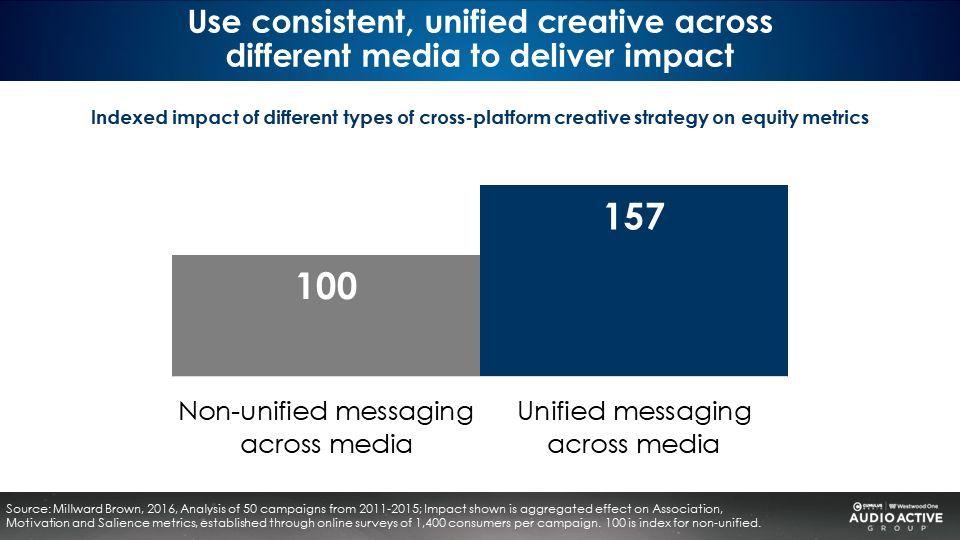
Leverage the appeal and trust of AM/FM radio personalities and podcast hosts
Local and national personalities are one of the superpowers of AM/FM radio and podcasts. They can be leveraged by advertisers and brands in many ways including live reads, endorsements, and recorded spots.
Utilizing trusted personalities in creative provides immediate credibility, endorsement, and relevance to listeners. With an already built in meaningful relationship existing between listeners and the people they listen to on broadcasts and podcasts regularly, advertisers benefit from having their ads read by DJs and hosts.
Host-read ads perform best and drive likelihood to seek information, purchase, and recommendation intent
According to a Nielsen study, host-read ads outperformed non-host-read ads across a variety of important brand metrics: likelihood to seek information (outperformed by +60%), purchase intent (+50%), and intent to recommend (+50%).
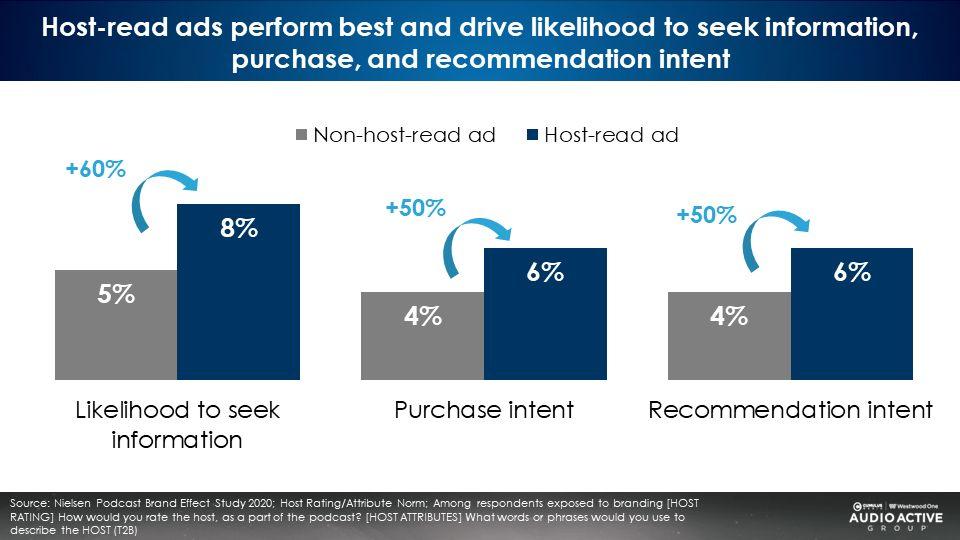
Host-read ads generate greater consumer attentiveness
In a March 2022 consumer study of 1,000 Americans 18+, Nielsen found 56% of podcast listeners and 44% of AM/FM radio listeners agreed that ads delivered by a host or personality got more of their attention than a pre-produced recorded commercial.
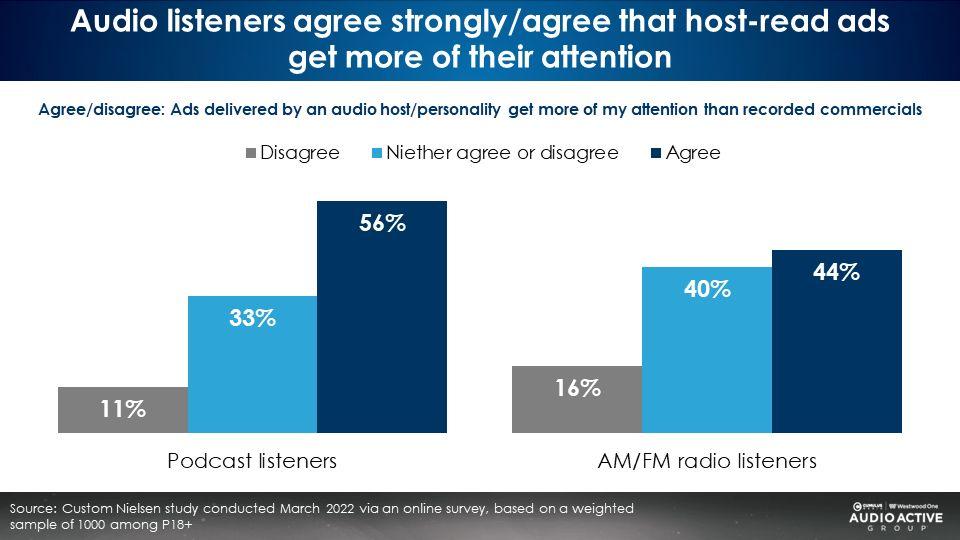
Creative and effectiveness go together
In their book How Not to Plan: 66 Ways to Screw it Up, Les Binet and Sarah Carter extol the value of quality creative: “Ads that win creative awards are much more effective than ads that don’t. And the more creative awards they win, the more effective they tend to be. But the striking finding is how efficient creative campaigns are. Ads that win creative awards are 11 times more efficient at selling stuff than other ads.”
Paying attention to the creative used in audio ads will never be wasted time. Armed with these best practices, advertisers and brands can develop quality audio creative that can move the sales needle.
Key takeaways:
- The jobs of marketing: Converting existing demand and creating future demand
- The first five seconds matter: Say the brand early and often
- Don’t get caught up on spot length: While longer ads do perform marginally better, in the grand scheme of audio creative, the length of an ad is a minor factor in effectiveness
- The fewer messages, the better the advertising recall
- Use consistent creative with a unified message across different media
- Leverage the appeal and trust of AM/FM radio personalities and podcast hosts
- Host-read ads perform best and drive likelihood to seek information, purchase, and recommendation intent
Click here to view a 10-minute video of the key findings.
Download Cumulus Media | Westwood One Audio Active Group®’s full guide to Audio Creative Best Practices.
Pierre Bouvard is Chief Insights Officer of the Cumulus Media | Westwood One Audio Active Group®.
Contact the Insights team at CorpMarketing@westwoodone.com.